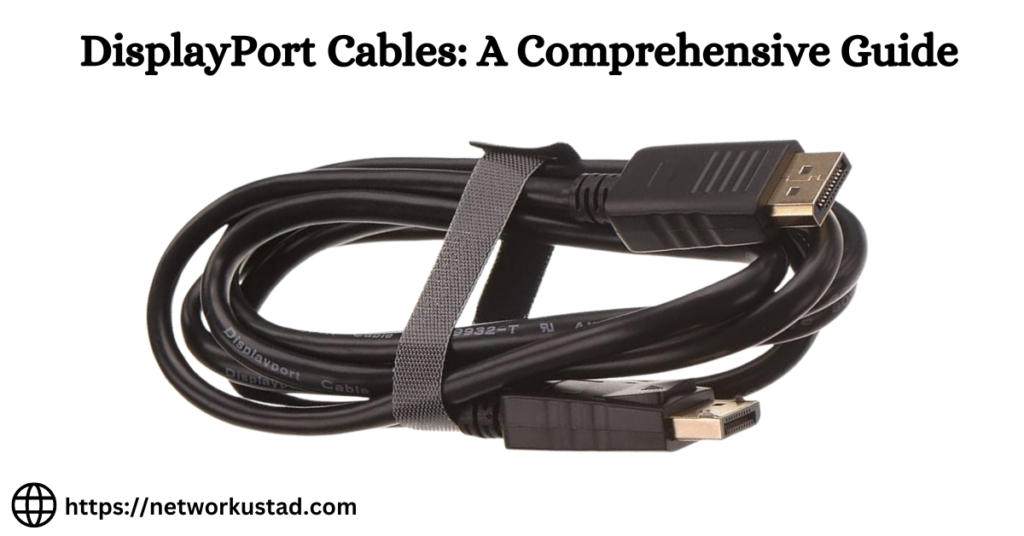Digital displays have become so flexible that you must establish the proper connection to ensure optimum performance. DisplayPort cables have become the leading technology for high-definition video and audio transmission, packed with all the newest features. The guide on DisplayPort technology is not just a simple one. It will take you through the world of DisplayPort technology, featuring compatibility, advancement, and technical aspects that will give you a thorough understanding of the DisplayPort display interface.
Understanding DisplayPort Features
DisplayPort cables deliver more advanced video and audio quality because they align with the trend of modern high-resolution displays. The Standard Series DisplayPort 1.2a cable, for instance, supports resolutions up to 4096 x 2160 at 60Hz with a color depth of 4:4:4. In addition, the feature that makes it operate with the bandwidth of up to 21.6Gbps is the ideal one for Ultra High Definition (UHD) displays so that its displays will be sharp and clear without matter what type of applications you use it for. Whether you need this for professional work or immersive entertainment, DP 1.4 will ensure you get the best experience possible.
However, DisplayPort cables offer much more than high-resolution capability. They also support Multi-Stream Transport (MST). This function enables the connection of more than one monitor through a single DisplayPort port, a vital benefit for workstations with more displays. These displays are commonly used in professional workstations, content creation environments, and gaming setups. The MST approach simplifies the cabling system and saves space as multiple cables and graphics ports become unnecessary.
Moreover, the DisplayPort utilizes Adaptive Sync, a feature that syncs the graphics card’s frame rate with the display’s refresh rate. It removes screen tearing and stuttering, resulting in smoother visuals and viewer experience, especially for fast-paced content such as video games, action movies, etc.
Compatibility and Adaptability: Bridging the Gap
The fact that DisplayPort is ready for use with older display technologies is one of the main benefits of the DisplayPort technology. The DisplayPort cables of today have backward compatibility with the DP 1.2 and 1.1 standards of the previous years, which means that users have a future-proof option and do not have to worry about buying any new cables if they purchase a new device.
Advancements in DisplayPort Technology: Pushing the Boundaries
DisplayPort technology continues to develop to meet the everyday needs of high-resolution displays with high-refresh-rate content by providing high data transfer rates. The DisplayPort 2.0 standard, introduced in 2016, increased data rates three times faster than DisplayPort 1.4a. These advancements include resolutions up to 16K, higher refresh rates, and HDR (High Dynamic Range).
Later, in 2022, VESA announced DisplayPort 2.1, further pushing the boundaries with new cable certifications for even higher speeds. In addition to this, the standard defines two other classes: UHBR10 (40 Gbit/s) and UHBR20 (80 Gbit/s). Through the latest improvements, the display module provides compatibility with such advanced technologies as 8K resolution with a high refresh rate and HDR support, which gives you a really immersive and visually stunning experience.
Interestingly, DisplayPort cables are continuously being advanced and compatible with DisplayPort devices produced for all different versions and certification levels. This universal compatibility is a common feature of the DisplayPort standard. It guarantees the product’s robustness and the developers’ foresight, giving users peace and enabling them to use the standard for a long time.
Transmission Speeds and Cable Types: Understanding the Options
DisplayPort cables can transmit at various speeds to satisfy the varying requirements of different activities. Among the seven modes, the ranger spread from RBR (Reduced Bit Rate) to UHBR 20 (Ultra High Bit Rate 20) varies in bandwidth. Nevertheless, not all cables support high bandwidth rates. VESA has developed an optional certification program for wires available at several bandwidth levels for clarity and compatibility, ultimately giving consumers more options to choose the right one for their needs.
Physically, DisplayPort connectors come in two main types: the traditional “full-size” connector and the smaller “mini” connector, which were first designed by Apple and later adopted by VESA. However, both connectors can perform the same functions, and the only difference you will notice is the shape and size, with the mini connector being more suitable for smaller devices such as laptops or tablets.
Cable Length and Connector Quality: Ensuring Optimal Performance

Maximum cable lengths do not cap the DisplayPort standard, but there are minimum requirements for cables up to 2 meters to support HBR2 speeds. For distances more than the active cables that include built-in signal amplification may be needed to keep the signal quality and prevent degradation.
High-grade connectors, such as those with gold plating, improve performance efficiency by reducing signal loss and resistance. Other connectors include latches for a solid connection, featuring a press button for quick and safe unplugging, thus providing convenience and preventing accidental disconnections.
Conclusion
DisplayPort cables are a multi-faceted and powerful tool that combines video sources and displays. They provide high-definition video and audio transmission capability, are backwards compatible, and can be interfaced with different devices. It is also worth noting that this process is ongoing, so users might enjoy even better performance and added features.
The reason why customers who want a reliable and high-quality connection that meets the requirements of the current digital communication are the ones who opt for DisplayPort cables.





